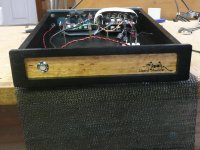Looking at the PCB layout the two solder blobs next to the plug are the same points so you can measure across those if its easier.
you can probably tell I'm a complete beginner 😀
There is 118ACV across the point you mentioned.
you can probably tell I'm a complete beginner 😀
There is 118ACV across the point you mentioned.
No problem at all 🙂
118 volts AC.
Hmmm... now that unfortunately does sound like the display itself is faulty. I would expect that 118 volts to vary if you turn the pot, but 118 volts means the invertor is working OK and producing that high voltage from the lower 9 volt supply.
The 8.85 volts from the regulator is within spec.
Theres not much else you can do now other than try another display. Thats a pity really.
No problem at all 🙂
118 volts AC.
Hmmm... now that unfortunately does sound like the display itself is faulty. I would expect that 118 volts to vary if you turn the pot, but 118 volts means the invertor is working OK and producing that high voltage from the lower 9 volt supply.
The 8.85 volts from the regulator is within spec.
Theres not much else you can do now other than try another display. Thats a pity really.
THANK YOU, for all of your help, the display's are ridiculously expensive here in OZ so I will just put up with it until I have the spare cash to buy a new one.
One, or should I say two, last questions;
Why do they put a 1K resistor on the input of a LED?
I have an illuminated switch on my DIY MiniDSP the illumination runs on a 12v supply, how can I dim the light? Add a resistor?
Many Thank
David
Attachments
The resistor in series wih the LED limits the current.
Unlike a filament bulb the LED always drops a constant voltage and that voltage varies with the colour of the LED too due to the physical properties of the different materials.
A typical value would be say 5 milliamps. Modern high brightness types are very efficient though, so thats a ball park figure. 50 milliamps would be an absolute max before damage occured, again a general figure.
So to dim the LED you add more resistance in series with it. On 12 volts you would calculate it as 12 minus the volt drop of the LED (say 1.7 for red) and use ohms law knowing what current you wanted.
12-1.7/5e-3 which is 2060 ohms for 5 milliamps.
For your LED I would use trial and error as its the only way to get the brightness where you want. You might find even 10k or higher is needed if its an efficient LED.
----------------------------------------------------------------------------------------------------------
Back to the NAD. I have never tried this but if the failed backlight is opaque would it be possible to iluminate it from the side or behind using say an high efficiency LED or LED's. Its just a thought although it may be that that type of display isn't suitable for backlighting in that way... I don't know. Worth maybe seeing if a bright light near the back or side helps and if so investigate... it might make it at least more readable.
Unlike a filament bulb the LED always drops a constant voltage and that voltage varies with the colour of the LED too due to the physical properties of the different materials.
A typical value would be say 5 milliamps. Modern high brightness types are very efficient though, so thats a ball park figure. 50 milliamps would be an absolute max before damage occured, again a general figure.
So to dim the LED you add more resistance in series with it. On 12 volts you would calculate it as 12 minus the volt drop of the LED (say 1.7 for red) and use ohms law knowing what current you wanted.
12-1.7/5e-3 which is 2060 ohms for 5 milliamps.
For your LED I would use trial and error as its the only way to get the brightness where you want. You might find even 10k or higher is needed if its an efficient LED.
----------------------------------------------------------------------------------------------------------
Back to the NAD. I have never tried this but if the failed backlight is opaque would it be possible to iluminate it from the side or behind using say an high efficiency LED or LED's. Its just a thought although it may be that that type of display isn't suitable for backlighting in that way... I don't know. Worth maybe seeing if a bright light near the back or side helps and if so investigate... it might make it at least more readable.
I have the same issue here with one, changed out the capacitors and still no difference, varied the pot and no difference, does anyone know where these displays are available. Contacted NAD UK agent and no longer supported (you knew right?) so the quest begins for a new display module, as I really don't want to throw the player away - only used in the house second system but does a fine job
The display appears to be actually working in itself just no form of backlighting, Chris
Back in 2011 when I had the problem you could buy the display but it was cheaper to buy a good second hand player.
- Status
- Not open for further replies.
- Home
- Source & Line
- Digital Source
- NAD Display Very Dim
